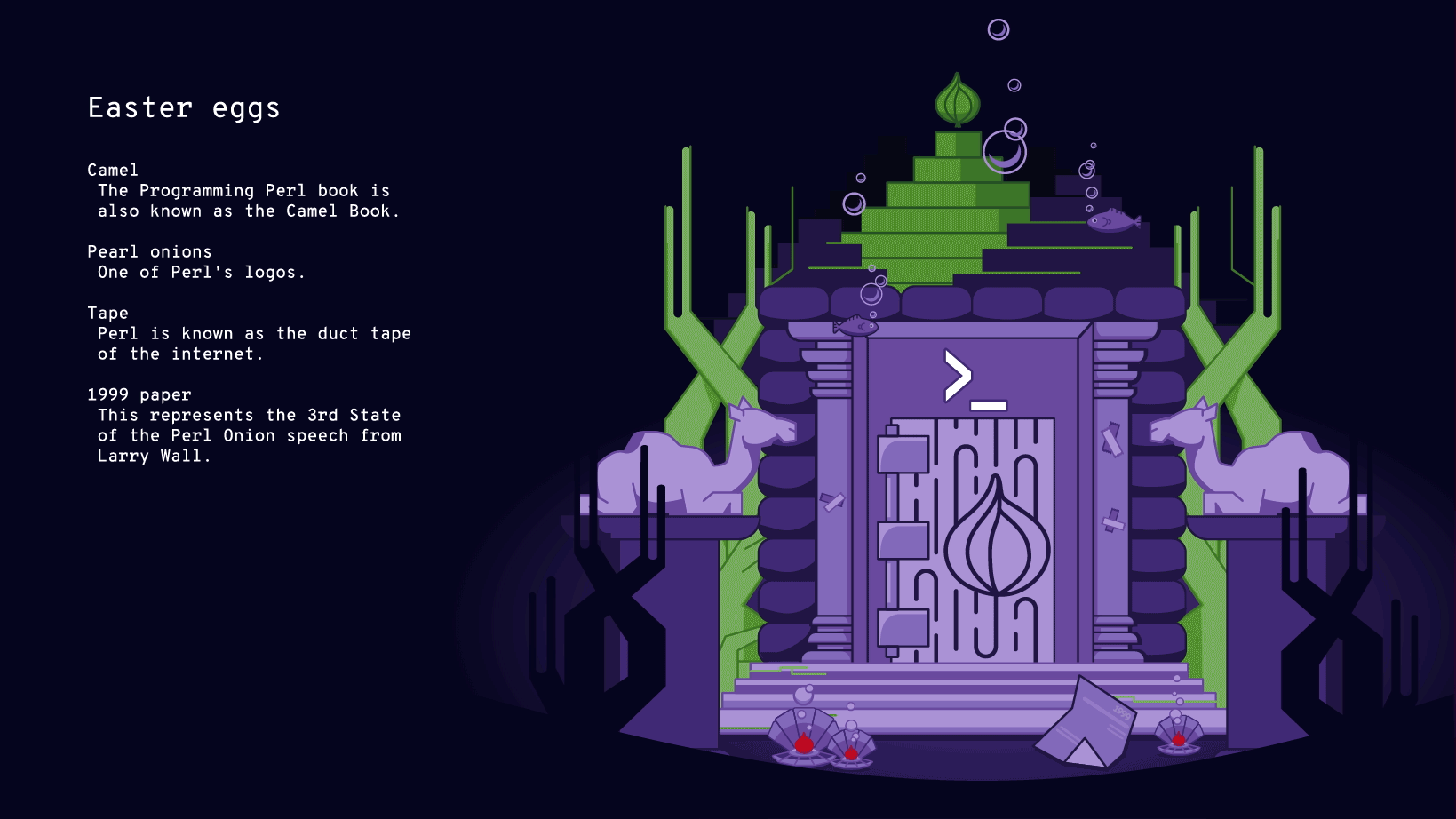Diving for Perl presented a unique challenge for us: how do we depict a language that was once one of the most popular in programming, without then implying it’s unwanted or in ruins? We wanted to tell Perl’s story while also staying true to its current status—a powerful language with an active community.
What was your research process for uncovering the history of Perl?
Karen Crowson, Designer: I didn’t do much research into Perl’s actual source code, but took a lot from its visuals and its history. We placed this one in the water because of the name of the episode: Diving for Perl. But that’s not what we started with. Our first idea was to have it in a jungle, inspired by the lost cities of Cambodia. We wanted to allude to something that had its heyday, but then fell from prominence. But we wanted to make sure that it didn't look like ruins—because this is a language that is still used today and loved. That’s when we decided to lean more on the title’s pun instead.
What was your biggest influence for this episode’s art?
Karen: Perl’s own visuals played a part. We pay homage to both Perl logos: the onion and the camels.
Johan Philippine, Copywriter: Playing around with the idea of a pearl was especially helpful, and along with the title led us to the underwater setting. We struggled a bit with the decision to placing it underwater, since episode four’s “land” is on the arrow section of the Command Line Heroes logo—out of the water. Would we move it and change the path to one of the water points, then go back to land for the next episode? We decided it wouldn’t be worth it, and to keep it where it was—especially since pearl diving happens in both fresh water and in coastal waters. We kept the ancient temple too, but in good condition—even if it is underwater.
What’s your favorite part of this episode’s art?
Karen: The fact that it’s underwater. It’s different than the rest, and it lent itself to some simple animations. I was also able to play around with how I placed the components, like the Perl onion as a pearl.
Was it immediately obvious how you’d animate this artwork?
Laura Walters, Animator: There was talk about how to move from land to sea in this episode, ultimately the best way I found to animate that was accentuating the plunge into the water, reflecting the episode title, “Diving for Perl”. We used lots of fun bubbles, fish drivebys, and some underwater caustics helped it feel more immersive.

Did it turn out how you expected?
Karen: It turned out to be better I think. Before it was on land. It wasn’t until it was revisited closer to the launch of the episode that we placed it underwater and we’re able to add in more elements.
We’re always happy when a good pun leads to good ideas. Diving for Perl’s artwork is available for download on the episode page. Next time, we’ll tell you all about the artwork for COBOL and Go, and the easter eggs hidden in our infrastructure.
Über den Autor
Nach Thema durchsuchen
Automatisierung
Das Neueste zum Thema IT-Automatisierung für Technologien, Teams und Umgebungen
Künstliche Intelligenz
Erfahren Sie das Neueste von den Plattformen, die es Kunden ermöglichen, KI-Workloads beliebig auszuführen
Open Hybrid Cloud
Erfahren Sie, wie wir eine flexiblere Zukunft mit Hybrid Clouds schaffen.
Sicherheit
Erfahren Sie, wie wir Risiken in verschiedenen Umgebungen und Technologien reduzieren
Edge Computing
Erfahren Sie das Neueste von den Plattformen, die die Operations am Edge vereinfachen
Infrastruktur
Erfahren Sie das Neueste von der weltweit führenden Linux-Plattform für Unternehmen
Anwendungen
Entdecken Sie unsere Lösungen für komplexe Herausforderungen bei Anwendungen
Original Shows
Interessantes von den Experten, die die Technologien in Unternehmen mitgestalten
Produkte
- Red Hat Enterprise Linux
- Red Hat OpenShift
- Red Hat Ansible Automation Platform
- Cloud-Services
- Alle Produkte anzeigen
Tools
- Training & Zertifizierung
- Eigenes Konto
- Kundensupport
- Für Entwickler
- Partner finden
- Red Hat Ecosystem Catalog
- Mehrwert von Red Hat berechnen
- Dokumentation
Testen, kaufen und verkaufen
Kommunizieren
Über Red Hat
Als weltweit größter Anbieter von Open-Source-Software-Lösungen für Unternehmen stellen wir Linux-, Cloud-, Container- und Kubernetes-Technologien bereit. Wir bieten robuste Lösungen, die es Unternehmen erleichtern, plattform- und umgebungsübergreifend zu arbeiten – vom Rechenzentrum bis zum Netzwerkrand.
Wählen Sie eine Sprache
Red Hat legal and privacy links
- Über Red Hat
- Jobs bei Red Hat
- Veranstaltungen
- Standorte
- Red Hat kontaktieren
- Red Hat Blog
- Diversität, Gleichberechtigung und Inklusion
- Cool Stuff Store
- Red Hat Summit

